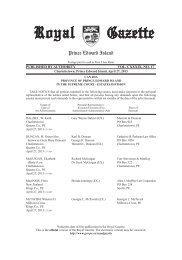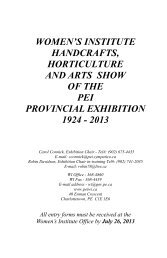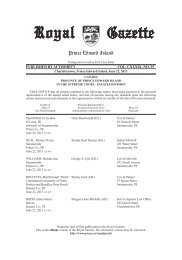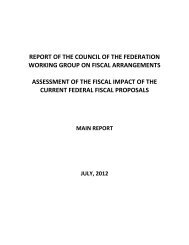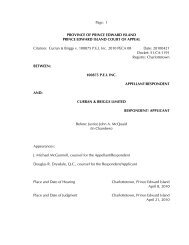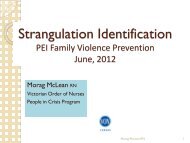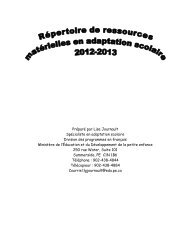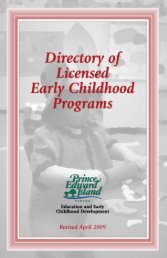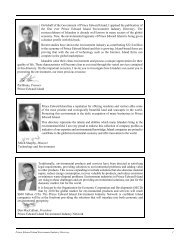Click here to read - The Government of Prince Edward Island
Click here to read - The Government of Prince Edward Island
Click here to read - The Government of Prince Edward Island
Create successful ePaper yourself
Turn your PDF publications into a flip-book with our unique Google optimized e-Paper software.
For many <strong>Island</strong>ers, the <strong>of</strong>ficial start <strong>of</strong><br />
spring is the opening day <strong>of</strong> the angling<br />
season. Call it a sport or a hobby,<br />
angling is a wonderful way <strong>to</strong> enjoy<br />
the natural beauty <strong>of</strong> our province and<br />
spend time with family and friends.<br />
<strong>The</strong> recreational fishery on <strong>Prince</strong><br />
<strong>Edward</strong> <strong>Island</strong> involves about 7,000<br />
<strong>Island</strong>ers and close <strong>to</strong> 1,000 nonresidents<br />
each year. <strong>The</strong> Department<br />
<strong>of</strong> Environment, Energy and Forestry is committed <strong>to</strong><br />
improving the sport fishery and increasing the opportunities<br />
available for anglers <strong>to</strong> enjoy their sport. Funds are<br />
provided <strong>to</strong> watershed groups <strong>to</strong> support habitat res<strong>to</strong>ration<br />
efforts across the province. <strong>Government</strong> staff provide<br />
technical assistance <strong>to</strong> these groups as they work diligently<br />
<strong>to</strong> improve the health <strong>of</strong> their watersheds. We are pleased<br />
<strong>to</strong> <strong>of</strong>fer funding support for fish s<strong>to</strong>cking, recognizing that<br />
s<strong>to</strong>cking plays an important role in fisheries management<br />
in PEI.<br />
A reminder that t<strong>here</strong> is now a five-day, family fish licence<br />
allowing a spouse and dependents <strong>to</strong> fish over a five<br />
day period. I encourage families <strong>to</strong> take advantage <strong>of</strong><br />
this economical way <strong>to</strong> spend quality time <strong>to</strong>gether in the<br />
outdoors. We will once again be hosting a Family Fishing<br />
Weekend (May 21-24 th inclusive). During this time, no<br />
angling licence is required.<br />
Have a safe and enjoyable 2010 angling season.<br />
Richard E. Brown, Minister<br />
Environment, Energy and Forestry
Table <strong>of</strong> Contents<br />
What’s New for 2010 ............................................... 3<br />
<strong>The</strong> Atlantic Salmon Conservation Foundation ....... 7<br />
Traditional Ancestral Homelands <strong>of</strong> the<br />
Mi’kmaq People .................................................... 9<br />
General Information - Definitions ............................. 11<br />
General Prohibitions ................................................14<br />
Angling Licences .....................................................16<br />
Wildlife Conservation Fund......................................19<br />
Season Dates and Creel Limits ...............................24<br />
Trout .....................................................................24<br />
Atlantic Salmon .....................................................25<br />
Waters with Special Regulations .............................28<br />
Morell River ..........................................................28<br />
Trout River ............................................................32<br />
Wilmot River .........................................................34<br />
Dunk River ............................................................34<br />
Souris River ..........................................................34<br />
Glenfinnan and O’Keefe Lakes.............................35<br />
Winter Ice Fishing and Ice Safety ............................36<br />
2010 Survey <strong>of</strong> Recreational Fishing ......................49
This booklet contains a summary <strong>of</strong> the fishing<br />
regulations and other information for persons who<br />
plan <strong>to</strong> fish in <strong>Prince</strong> <strong>Edward</strong> <strong>Island</strong>.<br />
Because this is a summary, not all <strong>of</strong> the laws<br />
contained in the Wildlife Conservation Act or<br />
regulations are included. For additional information<br />
contact the Department <strong>of</strong> Environment, Energy<br />
and Forestry or any <strong>of</strong> the Conservation Officers<br />
listed in this book.<br />
This is a summary prepared for the information<br />
and convenience <strong>of</strong> persons who plan <strong>to</strong> fish<br />
in <strong>Prince</strong> <strong>Edward</strong> <strong>Island</strong>. <strong>The</strong> original act and<br />
regulations should be consulted for all purposes<br />
<strong>of</strong> interpreting and applying the law. <strong>The</strong> rules<br />
contained in this angling summary are in<br />
compliance with the Maritime Provinces Fisheries<br />
Regulations in respect <strong>to</strong> close times, limits and<br />
quotas subject <strong>to</strong> variation under the authority <strong>of</strong><br />
<strong>The</strong> Fishery General Regulations.<br />
<strong>The</strong> laws are subject <strong>to</strong> change at any time.<br />
- 2 -
What’s New for 2010<br />
Conservation Measures on Souris River<br />
<strong>The</strong> angling season on Souris River will open on May<br />
15 th , 2010 with the exception <strong>of</strong> Harmony Pond which<br />
will open on April 15. As part <strong>of</strong> a research project,<br />
4,000 Atlantic salmon parr were s<strong>to</strong>cked in<strong>to</strong> Souris<br />
River in 2009 and the delayed opening will <strong>of</strong>fer<br />
protection as these fish migrate <strong>to</strong> sea.<br />
<strong>The</strong> section <strong>of</strong> the east branch, Souris River,<br />
upstream from the Souris Line Road will be closed<br />
<strong>to</strong> all angling for the period April 15 th <strong>to</strong> Oc<strong>to</strong>ber 15 th .<br />
This closure is in effect as a conservation measure <strong>to</strong><br />
protect a res<strong>to</strong>red brook trout nursery area.<br />
Conservation Closure Lifted on Tryon River<br />
<strong>The</strong> east branch, Tryon River, will be open <strong>to</strong> angling<br />
in 2010.<br />
Dunk River - Open with Restrictions<br />
<strong>The</strong> Dunk River has been restricted <strong>to</strong> catch and<br />
release fishing <strong>to</strong> allow s<strong>to</strong>cks <strong>to</strong> recover from an<br />
extensive fish kill in 2007. In 2010, anglers will be<br />
allowed <strong>to</strong> retain rainbow trout (up <strong>to</strong> eight per day).<br />
All brook trout must be released. See page 34 for<br />
details on gear restrictions.<br />
- 3 -
Extended Angling Season<br />
<strong>The</strong> Department <strong>of</strong> Environment, Energy and<br />
Forestry is committed <strong>to</strong> providing new opportunities<br />
for anglers. A number <strong>of</strong> watercourses (page 27)<br />
currently have an extended season <strong>to</strong> allow catch<br />
and release salmon angling in<strong>to</strong> Oc<strong>to</strong>ber. Please<br />
note that the extended season for these rivers will<br />
now end on Oc<strong>to</strong>ber 15 th , as opposed <strong>to</strong> Oc<strong>to</strong>ber<br />
31 st <strong>to</strong> reduce interference with trout spawning<br />
activity. In 2010, Souris River (page 35) will also<br />
have an extended season until Oc<strong>to</strong>ber 15 th , with<br />
artificial fly or lure - single barbless hook. A list <strong>of</strong><br />
rivers with extended season is found on page 27.<br />
<strong>The</strong> extended season in Leards Pond, Morell River,<br />
and Marchbank’s Pond, Wilmot River, will close on<br />
Oc<strong>to</strong>ber 31 st .<br />
2009 Changes - Reminder<br />
Trout<br />
Daily catch limit<br />
<strong>The</strong> daily catch limit <strong>of</strong> trout is eight (8) trout (either<br />
brook or rainbow).<br />
Possession limit<br />
In your possession, in the field and elsew<strong>here</strong> in<br />
s<strong>to</strong>rage, you may have no more than eight (8) trout in<br />
<strong>to</strong>tal.<br />
- 4 -
Atlantic Salmon<br />
T<strong>here</strong> will be no retention <strong>of</strong> Atlantic salmon. No tags<br />
will be issued. All angling for Atlantic salmon will be<br />
by barbless fly, catch and release only.<br />
Licences<br />
Family Fishing Licence<br />
A new 5 day family fishing licence is available<br />
after May 1 st . This licence allows the spouse and<br />
dependants <strong>to</strong> fish for a period <strong>of</strong> five days. <strong>The</strong> fee<br />
is $5 plus a $5 Wildlife Conservation Fund fee.<br />
Angling Licence<br />
Resident and non-resident licences have been<br />
combined in<strong>to</strong> one angling licence. <strong>The</strong> fee is $10<br />
plus the applicable Wildlife Conservation Fund Fee.<br />
Courtesy Angling Licence<br />
<strong>The</strong> courtesy resident licence option has been<br />
extended <strong>to</strong> persons age 16-18. In addition, persons<br />
age 60 and over are also eligible for this licence. <strong>The</strong><br />
spouse <strong>of</strong> the licence holder is no longer included<br />
with this licence. <strong>The</strong> Licence holder is required <strong>to</strong><br />
purchase a Wildlife Conservation Fund Licence.<br />
- 5 -
Are you interested in becoming a certified<br />
angling guide?<br />
Guiding is an excellent way <strong>to</strong> meet people and<br />
make some money while enjoying a day on one <strong>of</strong><br />
PEI’s beautiful streams. In recent years, requests<br />
for angling guides from visi<strong>to</strong>rs have been<br />
increasing. Emerit, the training program <strong>of</strong> the<br />
Canadian Tourism Human Resource Council, can<br />
provide a course leading <strong>to</strong> national certification<br />
as an angling guide. On PEI, the Tourism Industry<br />
Association <strong>of</strong> PEI (TIAPEI) provides course<br />
materials and administers the exam. If you are<br />
interested, please contact TIAPEI at 566-5008 or<br />
via email: tiapei@tiapei.pe.ca<br />
- 6 -
<strong>The</strong> Atlantic Salmon Conservation Foundation<br />
<strong>The</strong> Atlantic Salmon Conservation Foundation<br />
(ASCF) is an independent, federally incorporated,<br />
non-pr<strong>of</strong>it organization, which was established<br />
through a one-time grant <strong>of</strong> $30 million from the<br />
<strong>Government</strong> <strong>of</strong> Canada. <strong>The</strong> interest generated<br />
from investment <strong>of</strong> the grant will be used <strong>to</strong> support<br />
activities related <strong>to</strong> the conservation <strong>of</strong> the wild<br />
Atlantic salmon and its habitat.<br />
<strong>The</strong> goal <strong>of</strong> the Foundation is <strong>to</strong> help achieve healthy<br />
and sustainable wild Atlantic salmon s<strong>to</strong>cks in<br />
Atlantic Canada and Quebec through active working<br />
partnerships among volunteer conservation groups,<br />
Aboriginal organizations, governments, and others.<br />
Every year between November 1st and mid-<br />
December the Foundation calls for funding proposals<br />
for innovative, on-the-ground conservation projects<br />
focused on wild Atlantic salmon and its habitat<br />
carried-out by community groups. For 2010, a <strong>to</strong>tal<br />
<strong>of</strong> $300,000 will be available for consisting <strong>of</strong> $50,000<br />
for each <strong>of</strong> province, plus $50,000 for inter-provincial<br />
projects. To learn about the Foundation and how <strong>to</strong><br />
apply for funding please go <strong>to</strong> our website:<br />
www.salmonconservation.ca.<br />
<strong>Prince</strong> <strong>Edward</strong> <strong>Island</strong> Projects funded by<br />
the ASCF: Over $85,800 has been awarded <strong>to</strong><br />
conservation partners in <strong>Prince</strong> <strong>Edward</strong> <strong>Island</strong> in<br />
2008-2009.<br />
- 7 -
Pho<strong>to</strong> courtesy <strong>of</strong> the Trout Unlimited - <strong>Prince</strong> County Chapter<br />
Trout River Watershed Planning Project. Trout<br />
Unlimited - <strong>Prince</strong> County Chapter. Amount:<br />
$5,500.00.<br />
Development <strong>of</strong> an Atlantic Salmon Management<br />
Strategy for PEI. PEI Council <strong>of</strong> the Atlantic Salmon<br />
Federation. Amount: $44,500.00<br />
Support for Fish Friends elementary classroom<br />
program. ASF PEI Council. Amount: $1,000<br />
Souris & Area Wildlife Branch Salmon<br />
Res<strong>to</strong>ration Project. Souris & Area Branch Wildlife<br />
PEI Federation. Amount: $24,200<br />
Atlantic Salmon Conservation Stabilization<br />
Project Trout River. Trout Unlimited <strong>Prince</strong> County.<br />
Amount: $10,600<br />
- 8 -
Traditional Ancestral Homelands <strong>of</strong> the<br />
Mi’kmaq people<br />
<strong>The</strong> Traditional Ancestral Homelands <strong>of</strong> the Mi’kmaq<br />
People includes all <strong>of</strong> <strong>Prince</strong> <strong>Edward</strong> <strong>Island</strong>. In<br />
Mi’kmaq, <strong>Prince</strong> <strong>Edward</strong> <strong>Island</strong> is known as Epekwitk<br />
(pronounced E - PE - KWIT). Approximately 1,740<br />
Mi’kmaq Aboriginal people continue <strong>to</strong> live on PEI.<br />
In the early 1700’s the Mi’kmaq and the British<br />
entered in<strong>to</strong> peace, friendship, and trade treaties.<br />
<strong>The</strong> covenant chain <strong>of</strong> treaty relationships continues<br />
<strong>to</strong> this day. In 1982, the first Ministers <strong>of</strong> Canada<br />
affirmed and recognized Aboriginal and Treaty rights,<br />
now entrenched within the Constitution. In 1985, the<br />
Supreme Court <strong>of</strong> Canada confirmed that the treaty<br />
<strong>of</strong> 1752 is an existing treaty and protected under the<br />
Constitution. <strong>The</strong> courts also acknowledged that an<br />
Indian treaty is sui generis (unique).<br />
In 1990, the Supreme Court <strong>of</strong> Canada determined<br />
in the Sparrow decision that the Fisheries Act and<br />
Regulations were inconsistent with the Constitutional<br />
guarantee <strong>of</strong> an Aboriginal Right <strong>to</strong> fish. <strong>The</strong><br />
Supreme Court in the Sparrow decision recognized<br />
and affirmed the Aboriginal Right <strong>to</strong> access and use<br />
natural life aquatic resources, which is protected<br />
under section 35(1) <strong>of</strong> the Constitution Act <strong>of</strong> 1982.<br />
Aboriginal Peoples use <strong>of</strong> resources is undertaken,<br />
applying the principle <strong>of</strong> Netukulimk, a Mikmaq concept<br />
- 9 -
for responsible harvest <strong>of</strong> natural life resources <strong>to</strong><br />
provide for family and community while considering<br />
the future needs <strong>of</strong> generations yet <strong>to</strong> come.<br />
<strong>The</strong> Mi’kmaq People <strong>of</strong> Epekwitk have been<br />
harvesting animal, fowl, fish and plant life for<br />
over 10,000 years in Atlantic Canada. Since time<br />
immemorial, the Mi’kmaq have successfully managed<br />
the natural life resources for the expressed benefit<br />
and well being <strong>of</strong> community and family as the<br />
common wealth <strong>of</strong> the Mi’kmaq. Mi’kmaq/Aboriginal<br />
People maintain a traditional knowledge <strong>of</strong> the land,<br />
waters and natural life in and around <strong>Prince</strong> <strong>Edward</strong><br />
<strong>Island</strong>, the homelands <strong>of</strong> the Mi’kmaq - Epekwitk -<br />
Mi’kma’ki.<br />
For more information, contact:<br />
Jordan Crane<br />
Native Council <strong>of</strong> <strong>Prince</strong> <strong>Edward</strong> <strong>Island</strong><br />
Kelewatl Natural Life Harvesting Commission<br />
6 F.J. MacAulay Crt.,<br />
Charlotte<strong>to</strong>wn, PE C1A 9M8<br />
(W) (902) 892-5314<br />
(F) (902) 368-7464<br />
E-mail - Jordan@ncpei.com<br />
Randy Angus<br />
Mi’kmaq Confederacy <strong>of</strong> <strong>Prince</strong> <strong>Edward</strong> <strong>Island</strong><br />
70 Kent Street,<br />
Charlotte<strong>to</strong>wn, PE C1A 1M9<br />
(W)(902) 367-3660<br />
(F)(902) 436-0873<br />
Email: rangus@mcpei.ca<br />
- 10 -
General Information<br />
Definitions<br />
“Angling” means fishing with a line <strong>to</strong> which one or<br />
more hooks are attached and that is held in the hand<br />
or attached <strong>to</strong> a rod that is held in the hand or closely<br />
attended.<br />
“Artificial fly” means a single or double hook dressed<br />
with silk, tinsel, wool, fur, feathers or any combination<br />
<strong>of</strong> those or other materials commonly used in making<br />
artificial flies, but does not include a fly that has a<br />
spinning device, or a weight that causes the fly <strong>to</strong><br />
sink.<br />
“Artificial lure” means a device, comprised <strong>of</strong> wood,<br />
plastic, metal, feathers or any other inert material but<br />
no organic component, designed <strong>to</strong> catch fish.<br />
“Bait” means a natural or organic bait comprised<br />
<strong>of</strong> live or dead organisms (animals or plants),<br />
derivatives, or parts t<strong>here</strong><strong>of</strong>. This can include<br />
minnows, leeches, frogs, insects, worms, cut<br />
bait, corn, macaroni, pet food, cheese or similar<br />
substances. Fly materials, such as deer hair, or<br />
rubber baits impregnated with artificial scents are not<br />
considered organic bait.<br />
“Barbless hook” means a hook that was made without<br />
a barb or a hook that has all <strong>of</strong> its barbs compressed<br />
<strong>to</strong> be in complete contact with the shaft <strong>of</strong> the hook,<br />
except those barbs on the shank that are designed<br />
solely <strong>to</strong> retain bait.<br />
- 11 -
“Chumming” refers <strong>to</strong> the practice <strong>of</strong> using any<br />
material <strong>to</strong> attract fish <strong>to</strong> a particular location while<br />
angling.<br />
“Daily limit” refers <strong>to</strong> the lawful capture and retention<br />
<strong>of</strong> fish during a day, with angling restricted <strong>to</strong> the<br />
period <strong>of</strong> two hours before sunrise <strong>to</strong> two hours<br />
after sunset in any given day. <strong>The</strong> daily limit is one’s<br />
possession limit and is interpreted <strong>to</strong> be the only legal<br />
limit one can possess.<br />
“Fly fishing” means angling by the use <strong>of</strong> an artificial<br />
fly or flies that are attached <strong>to</strong> a line or <strong>to</strong> a leader<br />
that is attached <strong>to</strong> a line.<br />
“Grilse” means a salmon that is less than 63 cm but<br />
not less than 35 cm in length.<br />
“Hook” means a single, double or treble pointed hook<br />
on a common shank or shaft, with or without barbs.<br />
“Jigging” means fishing by manipulating one or more<br />
hooks so as <strong>to</strong> pierce a fish in any part <strong>of</strong> its body<br />
instead <strong>of</strong> luring the fish <strong>to</strong> take the hook or hooks<br />
in<strong>to</strong> its mouth.<br />
“Length” means:<br />
(a) in relation <strong>to</strong> a salmon or a landlocked salmon,<br />
the distance measured in a straight line from the tip<br />
<strong>of</strong> the nose <strong>to</strong> the fork <strong>of</strong> the tail,<br />
(b) in relation <strong>to</strong> any other fish referred <strong>to</strong> in these<br />
regulations, the distance measured in a straight line<br />
from the tip <strong>of</strong> the nose <strong>to</strong> the tip <strong>of</strong> the tail;<br />
- 12 -
“Possession limit” is interpreted <strong>to</strong> be one’s daily limit.<br />
“Sport fishing” means fishing for pleasure and not for<br />
sale or barter.<br />
“Sport fish” means salmon and trout.<br />
Did You Know?.....Size Matters!<br />
Brook trout grow quickly in PEI’s productive<br />
waters and by three years <strong>of</strong> age, are<br />
approximately 30 cm (12 inches) in length. <strong>The</strong><br />
largest brook trout are those that spend time in<br />
salt water. Although not common, these searun<br />
trout may grow <strong>to</strong> seven lbs. or more. Brook<br />
trout produce about 1,200 eggs per pound <strong>of</strong><br />
fish weight. T<strong>here</strong>fore, the big, wary fish that<br />
avoid being caught are those that make the most<br />
valuable spawners. Restrictions on the harvest<br />
<strong>of</strong> trout longer than 40 centimetres, the practice<br />
<strong>of</strong> catch and release fishing, and the imposition<br />
<strong>of</strong> conservation zones are useful management<br />
techniques <strong>to</strong> enhance the province’s trout fishery.<br />
- 13 -
General Prohibitions<br />
General Angling<br />
It is unlawful <strong>to</strong>:<br />
1. use a gill-net or trap-net for fishing in non-tidal or<br />
inland waters, unless authorized by the Maritime<br />
Provinces Fisheries Regulations;<br />
2. jig, snare or spear fish <strong>of</strong> any kind in non-tidal or<br />
inland waters;<br />
3. have in your possession an untagged salmon;<br />
4. fish with an artificial fly that has more than two<br />
hooks;<br />
5. angle with more than one fishing line or with a<br />
fishing line having more than three separate<br />
hooks;<br />
6. angle salmon except by fly fishing;<br />
7. angle within a 100-metre radius <strong>of</strong> any facility<br />
operated by or on behalf <strong>of</strong> the Department <strong>of</strong><br />
Fisheries and Oceans or the province for the<br />
purpose <strong>of</strong> counting passage or rearing <strong>of</strong> fish;<br />
9. angle within a fishway or within 25 metres<br />
downstream <strong>of</strong> the lower entrance <strong>of</strong> a fishway;<br />
10. angle in non-tidal or inland waters that are<br />
frequented by any sport fish during the closed<br />
time for that sport fish;<br />
11. angle during the time period extending from two<br />
hours after sunset <strong>to</strong> two hours before sunrise;<br />
- 14 -
12. export any trout from the province without a valid<br />
angling license and then only in accordance with<br />
the possession limit <strong>of</strong> 8 trout;<br />
13. litter at any time or place - conviction may result<br />
in loss <strong>of</strong> angling privileges;<br />
14. operate a mo<strong>to</strong>r boat while in<strong>to</strong>xicated;<br />
15. chum while angling for trout or salmon;<br />
16. possess, use or sell fish eggs as bait for angling;<br />
17. retain any sport fish alive while angling. All fish<br />
must be:<br />
a) immediately released alive back <strong>to</strong> the wild;<br />
or<br />
b) killed immediately and counted <strong>to</strong>wards the<br />
daily bag limit.<br />
18. No person shall possess fish that were caught<br />
by any person while fishing for recreational or<br />
sport purposes and that have been skinned, cut,<br />
packed or otherwise dealt with in such a manner<br />
that:<br />
(a) the species cannot be <strong>read</strong>ily determined;<br />
(b) the number <strong>of</strong> fish cannot be <strong>read</strong>ily<br />
determined;<br />
(c) w<strong>here</strong> size limits are applicable, the size <strong>of</strong><br />
the fish cannot be <strong>read</strong>ily determined.<br />
19. angle for striped bass;<br />
20. introduce or re-locate live fish species in<strong>to</strong> the<br />
waters <strong>of</strong> <strong>Prince</strong> <strong>Edward</strong> <strong>Island</strong>.<br />
- 15 -
Anglers are reminded that it is illegal <strong>to</strong> angle<br />
during the time period extending from two hours<br />
after sunset <strong>to</strong> two hours before sunrise. Official<br />
times <strong>of</strong> sunrise and sunset are published in local<br />
newspapers and can be found on the Environment<br />
Canada website: www.weather<strong>of</strong>fice.gc.ca<br />
Angling Licences<br />
Trout<br />
Trout angling licences can be obtained from<br />
authorized vendors and Access PEI centres<br />
throughout the province.<br />
Anglers have the option <strong>of</strong> purchasing their angling<br />
licence online. To access this service, please visit the<br />
website: www.gov.pe.ca /go/fishing<br />
Trout licences (resident and non-resident) entitle the<br />
licensee <strong>to</strong> angle brook and rainbow trout only. Youth<br />
under the age <strong>of</strong> 16 years are not required <strong>to</strong> obtain a<br />
trout angling licence.<br />
Resident/Non-Resident - $10<br />
Courtesy Licence-Free<br />
Available <strong>to</strong> residents only. Issued <strong>to</strong> anglers 16 <strong>to</strong><br />
18 and 60 years <strong>of</strong> age and over.<br />
Family Fishing Licence - $5<br />
This licence allows the spouse and dependants<br />
<strong>to</strong> fish for a period <strong>of</strong> 5 days. <strong>The</strong> licence will be<br />
available after May 1 st .<br />
- 16 -
<strong>The</strong> Forests, Fish and Wildlife Division<br />
encourages adults <strong>to</strong> take children fishing. <strong>The</strong><br />
adult does not require an angling licence while<br />
assisting the children as long as the number<br />
<strong>of</strong> fishing rods does not exceed the number <strong>of</strong><br />
children angling.<br />
All in a Name...<br />
All species <strong>of</strong> trout and salmon belong <strong>to</strong> the<br />
same family <strong>of</strong> fish - the Salmonidae. Brook trout<br />
are part <strong>of</strong> the genus or group called Salvelinus or<br />
char, while rainbow trout are more closely related<br />
<strong>to</strong> salmon. <strong>The</strong> brook or speckled trout is the<br />
most common salmonid on <strong>Prince</strong> <strong>Edward</strong> <strong>Island</strong>.<br />
Brook trout who spend some time in salt water<br />
are the most prized by sport fishers. <strong>The</strong>se are<br />
known as sea trout and can grow as large as 7 lbs<br />
or more!<br />
Brook trout, speckled trout, sea trout. Call them<br />
what you like, but they are all the same fish.<br />
- 17 -
Atlantic Salmon<br />
Salmon licences are available from Access PEI<br />
centres and a limited number <strong>of</strong> vendors. To angle<br />
for Atlantic salmon, one requires an Atlantic salmon<br />
angling licence in addition <strong>to</strong> a trout licence. All<br />
anglers, including youth under the age <strong>of</strong> 16 years,<br />
must obtain a salmon licence.<br />
Atlantic Salmon - $10<br />
Wildlife Conservation Fund<br />
All licensed anglers are required <strong>to</strong> be in<br />
possession <strong>of</strong> a Wildlife Conservation Fund<br />
Licence. Youth under the age <strong>of</strong> 16 are exempt from<br />
this licensing requirement.<br />
Wildlife Conservation Fund - $20<br />
For seniors 65 years <strong>of</strong> age and over:<br />
Wildlife Conservation Fund - $13<br />
For family five-day licence<br />
Wildlife Conservation Fund - $5<br />
For further information and a list <strong>of</strong> vendors, please<br />
call the Department <strong>of</strong> Environment, Energy and<br />
Forestry’s Forests, Fish and Wildlife Division,<br />
(902) 368-6080.<br />
- 18 -
PEI Wildlife Conservation Fund<br />
W<strong>here</strong> Does Your Money Go?<br />
When you pay a PEI Wildlife Conservation<br />
Fund fee, you are helping <strong>to</strong> improve habitat for<br />
fish and many other species <strong>of</strong> <strong>Island</strong> Wildlife.<br />
Applications for funding are made by many stream<br />
and river management groups annually. In 2009,<br />
approximately $162,000 was awarded <strong>to</strong> watershed,<br />
wildlife and environmental groups across PEI <strong>to</strong><br />
res<strong>to</strong>re, protect and improve <strong>Island</strong> waterways.<br />
Research and education projects were also funded.<br />
Groups receiving WCF funds in 2009 for river and<br />
stream related projects are listed below. For more<br />
information on the PEI Wildlife Conservation Fund<br />
you can call (902) 892-7513, email: wcfund@eastlink.<br />
ca, or visit the web at www.gov.pe.ca/go/wcf<br />
PEI Wildlife Federation<br />
Trout River Environmental Committee<br />
Trout Unlimited Canada - <strong>Prince</strong> Co. Chapter<br />
Tignish Watershed Management Co-op<br />
Wheatley River Improvement Group<br />
Mill River Wildlife Federation<br />
Richmond Bay Watershed Association<br />
Central Queens Wildlife Federation<br />
Hunter-Clyde Watershed Group<br />
Friends <strong>of</strong> Covehead and Brackley Bay Inc.<br />
Trout Unlimited Canada - PEI Chapter<br />
Black Pond Watershed Group<br />
- 19 -
PEI Trappers Association<br />
Souris and Area Branch <strong>of</strong> the PEI Wildlife Federation<br />
Desable River Enhancement and Activity Mgmt<br />
PEI Council <strong>of</strong> the Atlantic Salmon Federation<br />
West Point Community Enhancement Committee<br />
Wrights Creek Watershed Environmental Committee<br />
Leard’s Pond (Coleman) Committee<br />
Harmony and Area Watershed Group<br />
All in a Name...<br />
All species <strong>of</strong> trout and salmon belong <strong>to</strong> the<br />
same family <strong>of</strong> fish - the Salmonidae. Brook trout<br />
are part <strong>of</strong> the genus or group called Salvelinus<br />
or char, while rainbow trout are more closely<br />
related <strong>to</strong> salmon. <strong>The</strong> brook or speckled trout<br />
is the most common salmonid on <strong>Prince</strong> <strong>Edward</strong><br />
<strong>Island</strong>. Brook trout who spend some time in salt<br />
water are the most prized by sport fishers. <strong>The</strong>se<br />
are known as sea trout and can grow as large as<br />
7 lbs or more!<br />
Brook trout, speckled trout, sea trout. Call them<br />
what you like, but these are all the same fish.<br />
- 20 -
Why Use Barbless Hooks?<br />
Many anglers know that the mortality rate when<br />
releasing fish caught on lure or fly is considerably<br />
lower than that <strong>of</strong> bait fishing. However, using<br />
hooks without barbs, even when fishing with bait,<br />
can greatly improve the survival <strong>of</strong> fish caught and<br />
released. Studies have shown that the mortality<br />
rate when fishing with bait on a barbed hook is<br />
roughly 30%. This drops <strong>to</strong> approximately 8%<br />
for bait on barbless hooks. Angling mortality<br />
using barbed lures and flies is approximately<br />
5%, dropping <strong>to</strong> 2.5% using barbless hooks. Of<br />
course, care must be taken when handling and<br />
releasing fish <strong>to</strong> ensure a successful release.<br />
It is not difficult <strong>to</strong> transform a “barbed” hook in<strong>to</strong><br />
a “barbless” hook. Simply take a pair <strong>of</strong> pliers or<br />
a hemostat and compress the barb so it lies flat<br />
against the shaft <strong>of</strong> the hook. Talk <strong>to</strong> anglers who<br />
regularly use barbless hooks and they will tell you<br />
that they do not notice a difference in their ability <strong>to</strong><br />
hook and retain fish. It is far easier <strong>to</strong> release little<br />
fish caught on barbless hooks. An added bonus is<br />
the ease at which barbless hooks can be removed<br />
from your thumb! Give barbless hooks a try!<br />
- 21 -
Attention Anglers<br />
<strong>The</strong> waters <strong>of</strong> Atlantic Canada are cold year round.<br />
If you fall overboard, do not panic!<br />
Remember the 1 — 10 — 1 Principle<br />
YOU HAVE:<br />
• 1 minute <strong>to</strong> get your breathing under control;<br />
• 10 minutes <strong>of</strong> meaningful use <strong>of</strong> your arms and<br />
legs <strong>to</strong> stay afloat; and<br />
• 1 hour before you become unconscious due <strong>to</strong><br />
hypothermia.<br />
SAFETY TIPS:<br />
• Above all, WEAR A LIFEJACKET.<br />
• Always tell someone w<strong>here</strong> you are going and<br />
when you expect <strong>to</strong> return.<br />
• Keep a low centre <strong>of</strong> gravity and never overload<br />
your boat.<br />
- 22 -
Over 90 percent <strong>of</strong> anglers who die while boating<br />
are not wearing a lifejacket. When you fall<br />
overboard, a lifejacket s<strong>to</strong>red under your seat will<br />
do little <strong>to</strong> save your life. Before you head out on<br />
the water, make sure you wear a lifejacket that fits<br />
and is in good working order.<br />
Anglers are reminded <strong>to</strong> be sure <strong>to</strong> carry pro<strong>of</strong> <strong>of</strong><br />
competency such as a Pleasure Craft Opera<strong>to</strong>r<br />
Card, and pho<strong>to</strong> ID, if they are operating a boat<br />
fitted with a mo<strong>to</strong>r.<br />
Go <strong>to</strong> www.coldwaterbootcamp.com <strong>to</strong> learn about the<br />
crippling effects <strong>of</strong> cold water immersion. To prepare for a<br />
safe fishing adventure, visit www.boatingsafety.gc.ca or call<br />
1-800-387-4999 <strong>to</strong> speak with a Boating Safety Officer.<br />
- 23 -
Season Dates and Creel Limits<br />
Trout<br />
Open season - April 15 <strong>to</strong> September 15, inclusive;<br />
all waters with the following exceptions:<br />
• Glenfinnan and O’Keefe Lakes - have an extended<br />
season (see page 35)<br />
• Trout River (Coleman) - has a special Trout<br />
Management Zone with shortened season and<br />
specific regulations (see page 32)<br />
• Wilmot River - Marchbanks Pond has an extended<br />
season for trout (see page 34)<br />
• Souris River - has special regulations, including an<br />
extended season (see page 35)<br />
Daily catch limit <strong>of</strong> 8 trout, <strong>of</strong> which not more than<br />
one trout (either rainbow or brook) may be greater<br />
than 40 cm in length.<br />
- 24 -
Possession Limit - In your possession, in the field<br />
and elsew<strong>here</strong> in s<strong>to</strong>rage, you may have no more<br />
than 8 trout in <strong>to</strong>tal.<br />
<strong>The</strong> Dunk River will be open <strong>to</strong> catch and release<br />
fishing for brook trout in 2010 <strong>to</strong> allow fish s<strong>to</strong>cks <strong>to</strong><br />
recover following a fish kill in 2007. Rainbow trout<br />
can be retained (see page 34)<br />
Atlantic Salmon<br />
Atlantic Salmon<br />
Open Season - All waters June 1 <strong>to</strong> September 15,<br />
inclusive; except for Morell River (see page 28) and<br />
waters noted in the table on page 27.<br />
Daily catch and release limit <strong>of</strong> not more than two<br />
(grilse or salmon).<br />
- 25 -
All salmon must be released immediately with the<br />
least possible harm <strong>to</strong> the fish.<br />
Angling for Atlantic salmon is restricted <strong>to</strong> an artificial<br />
barbless fly as defined in Definitions, page 11. It does<br />
not include a fly that has a spinning device or weight<br />
that causes the fly <strong>to</strong> sink; however, a fly so altered<br />
can be used <strong>to</strong> angle for trout.<br />
- 26 -
Extended Season: <strong>The</strong> following waters are open<br />
<strong>to</strong> salmon fishing, catch and release, using barbless<br />
hooks only:<br />
River Date Location<br />
Mill<br />
River<br />
Trout<br />
River<br />
West<br />
River<br />
Morell<br />
River<br />
September 16<br />
<strong>to</strong> Oc<strong>to</strong>ber 15<br />
September 2<br />
<strong>to</strong> Oc<strong>to</strong>ber 15<br />
September 16<br />
<strong>to</strong> Oc<strong>to</strong>ber 15<br />
September 16<br />
<strong>to</strong> Oc<strong>to</strong>ber 31<br />
- 27 -<br />
Downstream<br />
fromHowlan<br />
highway culvert<br />
(Route 148)<br />
Downstream from<br />
Leards Pond in<br />
Coleman (Route<br />
140)<br />
Downstream<br />
from Green Bay<br />
highway culvert<br />
(Route249)<br />
see page 28-29
Waters with Special Regulations<br />
Morell River<br />
1. On any day, an angler who holds a salmon licence<br />
must cease all angling on the Morell River for that<br />
day after two fish, either salmon or grilse, have<br />
been caught and released, whichever occurs first.<br />
2. From April 15 <strong>to</strong> September 15, in the lower<br />
section <strong>of</strong> the Morell River from MacKay’s <strong>to</strong> the<br />
mouth <strong>of</strong> the river (railway bridge), trout may be<br />
taken on any tackle. This section <strong>of</strong> river is closed<br />
<strong>to</strong> all angling after September 15.<br />
3. Any Atlantic salmon must be released immediately<br />
with the least possible harm <strong>to</strong> the fish.<br />
4. Please note that salmon smolts migrate <strong>to</strong> sea<br />
during the month <strong>of</strong> May. Smolts are delicate<br />
at this time and can easily die if handled. If you<br />
find yourself catching numerous salmon smolts,<br />
please consider angling in a different location until<br />
the smolt run is diminished.<br />
5. <strong>The</strong> section <strong>of</strong> the East Branch <strong>of</strong> the Morell River<br />
containing the old Crane’s Pond dam site is closed<br />
<strong>to</strong> all angling for the period July 1 <strong>to</strong> September<br />
15. <strong>The</strong> section <strong>of</strong> river affected includes all<br />
waters 250 metres upstream <strong>of</strong> the highway<br />
bridge on Route 355. This closure is in effect as a<br />
conservation measure <strong>to</strong> protect trout broods<strong>to</strong>ck.<br />
- 28 -
6. Portions <strong>of</strong> the Morell River are <strong>to</strong> be angled only<br />
by fly fishing after June 1. <strong>The</strong> restriction applies<br />
<strong>to</strong> Leard’s Pond, River<strong>to</strong>n, the West Branch below<br />
Leard’s Pond, all that section <strong>of</strong> the East Branch<br />
below the Hazelgreen Road (Route 329); and the<br />
main section <strong>of</strong> the river from the point <strong>of</strong> union <strong>of</strong><br />
the West and East Branches <strong>to</strong> MacKay’s in the<br />
Bangor area.<br />
7. <strong>The</strong> extended season from September 16 <strong>to</strong><br />
Oc<strong>to</strong>ber 31st is for Atlantic salmon only, using<br />
barbless hooks.<br />
8. For the period September 16<br />
<strong>to</strong> Oc<strong>to</strong>ber 15 inclusive,<br />
salmon angling is restricted <strong>to</strong><br />
those areas on the Morell<br />
River as defined in Section 6<br />
above.<br />
9. Salmon angling on Leard’s<br />
Pond is permitted from<br />
June 1 <strong>to</strong> Oc<strong>to</strong>ber 31st,<br />
inclusive.<br />
- 29 -
Catch and Release Angling<br />
Anglers are becoming increasingly aware <strong>of</strong> the<br />
fragility <strong>of</strong> our environment and the pressure on<br />
the <strong>Island</strong>’s fishery resources. More anglers<br />
are discovering the enjoyment and sense <strong>of</strong><br />
satisfaction that can be obtained by releasing fish.<br />
When practising catch and release fishing, the<br />
following steps should be considered:<br />
• Use the right gear:<br />
Barbless or pinched hooks<br />
are easier <strong>to</strong> remove<br />
Artificial lures, not bait, reduce<br />
the chances <strong>of</strong> deep hooking<br />
• Minimize handling: retrieve your fish quickly and<br />
release it immediately<br />
• Keep the fish in the water<br />
• Use only a knotless mesh net<br />
• Remove the hook carefully<br />
• Cut the leader if necessary<br />
• Hold the fish gently<br />
in a natural swimming<br />
position, facing<br />
upstream until<br />
it revives<br />
- 30 -
Morell River<br />
- 31 -
Trout River<br />
T<strong>here</strong> is a Trout Management Zone in place on the<br />
Trout River in Coleman which includes:<br />
Leards Pond in Coleman (Route 140)<br />
downstream <strong>to</strong> a point 200 metres below<br />
G<strong>of</strong>fs Bridge at Route 12:<br />
Open trout season is May 1 <strong>to</strong> September 1, 2010<br />
Daily bag limit and possession limit <strong>of</strong> six (6) trout,<br />
<strong>of</strong> which only one may be greater than 35 cm in<br />
length.<br />
- 32 -
Trout River (Coleman)<br />
- 33 -
Wilmot River<br />
Marchbanks Pond<br />
Angling within Marchbank’s Pond is extended<br />
from September 16 <strong>to</strong> Oc<strong>to</strong>ber 31, 2010. <strong>The</strong><br />
extension affects that part <strong>of</strong> the Wilmot River<br />
between the road stream intersection at Highway<br />
120 (McMurdo Road) and the intersection <strong>of</strong><br />
Klondike Brook with the Wilmot River (tributary<br />
at upper end <strong>of</strong> pond on south side). Catch and<br />
release fishing with fly, using barbless hooks.<br />
Dunk River<br />
<strong>The</strong> Dunk River will have special restrictions in 2010<br />
<strong>to</strong> allow fish s<strong>to</strong>cks <strong>to</strong> recover following a fish kill in<br />
2007.<br />
• Catch and release fishing for brook trout; rainbow<br />
trout can be retained.<br />
• Barbless hooks only (barbs can be pinched - see<br />
page 21 for details)<br />
• Artificial lure and fly only - use <strong>of</strong> organic bait is not<br />
permitted (refer <strong>to</strong> definitions on page 11)<br />
• Angling season - April 15 <strong>to</strong> September 15 (t<strong>here</strong><br />
will be no extended season in 2010)<br />
Some tips on catch and release fishing are given on<br />
page 30.<br />
Souris River<br />
• <strong>The</strong> angling season on Souris River will open on<br />
May 15, 2010, with the exception <strong>of</strong> Harmony<br />
Pond which will open on April 15th.<br />
- 34 -
• <strong>The</strong> section <strong>of</strong> the east branch, Souris River,<br />
upstream from the Souris Line Road will be closed <strong>to</strong><br />
all angling for the period April 15th <strong>to</strong> Oc<strong>to</strong>ber 15th.<br />
• Angling on the Souris River is extended from<br />
September 15th <strong>to</strong> Oc<strong>to</strong>ber 15th in all that section<br />
<strong>of</strong> the main river below the Gowanbrae Bridge on<br />
Souris River Road (Route 358). Artificial fly or lure<br />
- Single barbless hooks only.<br />
Glenfinnan and O’Keefe’s Lakes<br />
O’Keefes Lake and Glenfinnan Lake are periodically<br />
s<strong>to</strong>cked with rainbow trout in support <strong>of</strong> a put and<br />
take fishery.<br />
• Open season for rainbow trout is April 15 <strong>to</strong><br />
November 15<br />
• Glenfinnan Lake has a daily catch limit <strong>of</strong> 5<br />
rainbow trout, only one <strong>of</strong> which can be greater<br />
than 40 cm. <strong>The</strong> O’Keefe’s Lake is catch and<br />
release only.<br />
• Possession limit <strong>of</strong> 5 rainbow trout<br />
Please Note: Regular moni<strong>to</strong>ring <strong>of</strong> fish in O’Keefe’s<br />
Lake has indicated that mercury levels can be in<br />
excess <strong>of</strong> recommended guidelines. <strong>Prince</strong> <strong>Edward</strong><br />
<strong>Island</strong>’s Chief Health Officer advises that fish from<br />
O’Keefe’s Lake should not be eaten. Fish from other<br />
lakes, ponds or brooks on P.E.I have not been found<br />
<strong>to</strong> have mercury above the national guidelines.<br />
- 35 -
Winter Ice Fishing<br />
Winter ice fishing is restricted <strong>to</strong> Glenfinnan<br />
and O’Keefe’s Lakes. Those anglers wishing <strong>to</strong><br />
participate in the winter ice fishery should retain<br />
both their Trout Angling Licence and the Wildlife<br />
Conservation Licence.<br />
• Winter ice fishing from January 1 <strong>to</strong> March 31,<br />
2010.<br />
• Catch limit and possession limit as outlined above<br />
Ice Safety<br />
Traditionally, some ponds and rivers are iced over<br />
on opening day <strong>of</strong> the angling season, while the<br />
winter trout fishery is dependent on ice. To avoid a<br />
potentially life threatening situation, practise caution<br />
when fishing on ice.<br />
• For your safety t<strong>here</strong> should be at least 15 cm (six<br />
inches) <strong>of</strong> ice or more for small groups <strong>of</strong> people;<br />
and 25 cm (10 inches) or more for snowmobiles<br />
and all terrain vehicles.<br />
• Plan <strong>to</strong> fish with a friend.<br />
• Children should be supervised by an adult.<br />
• Dress warmly - wear a hat, scarf and mitts.<br />
• Wearing a personal flotation device like a floater<br />
coat is a good idea when ice fishing.<br />
- 36 -
Should you break through the ice, extend your arms<br />
flat on the ice surface and kick your feet. Try <strong>to</strong><br />
squirm the upper part <strong>of</strong> your body on<strong>to</strong> the ice. Once<br />
out <strong>of</strong> the water, roll quickly <strong>to</strong> one side away from<br />
the edge. Once you reach safety, get <strong>to</strong> shore and<br />
warm yourself by building a fire and getting in<strong>to</strong> dry<br />
clothing.<br />
- 37 -
W<strong>here</strong> Does the Hook Go?<br />
Many anglers are unaware<br />
<strong>of</strong> the location <strong>of</strong> vital<br />
organs in a fish. When<br />
fish are hooked in the lips<br />
or jaw area, mortality can<br />
be less than 1%. However,<br />
fish that are “deep hooked” in the esophagus or<br />
gills suffer a high mortality rate. Studies have<br />
shown that many fish which are deeply hooked<br />
suffer major internal damage <strong>to</strong> the heart, s<strong>to</strong>mach<br />
or liver.<br />
<strong>The</strong> fish may appear unharmed and swim away,<br />
only <strong>to</strong> die a few hours later. Use equipment<br />
and techniques which will allow you <strong>to</strong> catch and<br />
release fish unharmed.<br />
Is it a salmon or brook trout?<br />
Anglers may confuse brook trout with Atlantic salmon,<br />
particularly in the spring when “slink” salmon are<br />
in the rivers. “Slink” or “black” salmon are fish that<br />
returned <strong>to</strong> the river the previous year, spawned in<br />
the fall, and are preparing <strong>to</strong> return <strong>to</strong> sea again in<br />
spring. Unlike fresh salmon, these fish tend <strong>to</strong> be<br />
dark and rather thin. If you hook a slink salmon,<br />
- 38 -
please take care when releasing the fish <strong>to</strong> ensure<br />
minimal harm. To distinguish between the two fish,<br />
look for the telltale spots on the body <strong>of</strong> the brook<br />
trout (orange and red spots fringed with blue) and<br />
white edge on the fins.<br />
Atlantic salmon undergo a number <strong>of</strong> physiological<br />
changes which allow them <strong>to</strong> move from fresh water<br />
<strong>to</strong> salt water. On PEI, smolts move out <strong>of</strong> the rivers<br />
in<strong>to</strong> salt water in May. <strong>The</strong>y are quite delicate at this<br />
time and can easily die if handled. If you find yourself<br />
catching numerous salmon smolts, please consider<br />
angling in a different location until the smolt run is<br />
diminished.<br />
Atlantic salmon “slink”<br />
Brook trout<br />
- 39 -
Take Your Family Fishing on the Long<br />
Weekend in May!<br />
Take your children fishing and let them experience<br />
the great outdoors and enjoy a life long pleasure<br />
that comes from fishing. <strong>The</strong> Department <strong>of</strong><br />
Environment, Energy and Forestry encourages<br />
parents <strong>to</strong> share the weekend <strong>of</strong> May 21-24,<br />
2010 with their kids fishing. In support <strong>of</strong> this<br />
adventure, no licence will be required <strong>to</strong> fish<br />
over the Vic<strong>to</strong>ria Day long weekend, May 21-24<br />
inclusive.<br />
- 40 -
Report poachers and<br />
polluters!<br />
Call Crime S<strong>to</strong>ppers<br />
<strong>to</strong>ll-free<br />
1-800-222-8477<br />
Report Litterers!<br />
Call the hot line<br />
<strong>to</strong>ll-free<br />
1-866-368-5024<br />
- 41 -
Investigation and Enforcement<br />
For enforcement <strong>of</strong> any <strong>of</strong> the environment acts<br />
or regulations during regular working hours,<br />
telephone a Conservation Officer at any <strong>of</strong> the<br />
following locations:<br />
O’Leary 859-8800 Aaron Waddell<br />
Welling<strong>to</strong>n/ 854-7250 Roland Richard<br />
(bilingual <strong>of</strong>ficer)<br />
Summerside 888-8000<br />
Charlotte<strong>to</strong>wn (Chief 368-4808 John Clements<br />
Conservation Officer)<br />
368-5000 Wade MacKinnon<br />
Queens County 368-5000 Sandra Keough<br />
Montague 838-0600 Locke Jones<br />
Souris 687-7000 Trevor MacKinnon<br />
For environmental or enforcement emergencies after<br />
normal <strong>of</strong>fice hours, telephone 1-800-565-1633.<br />
- 42 -
Access PEI Centres<br />
Queens County<br />
Charlotte<strong>to</strong>wn ...............................................368-5200<br />
Kings County<br />
Montague......................................................838-0600<br />
Souris ..........................................................687-7000<br />
<strong>Prince</strong> County<br />
Alber<strong>to</strong>n ........................................................853-8622<br />
O’Leary .........................................................859-8800<br />
Summerside .................................................888-8000<br />
Tignish ..........................................................882-7351<br />
Welling<strong>to</strong>n .....................................................854-7250<br />
- 43 -
- 44 -
White Perch<br />
• Found in many <strong>Prince</strong><br />
<strong>Edward</strong> <strong>Island</strong> rivers and<br />
are commonly present in<br />
bays, tidal tributaries and barrier beach ponds<br />
along the shore,.<br />
• Close relative <strong>of</strong> striped bass.<br />
• Can reach sizes <strong>of</strong> 19 inches (48cm) and 4 ½ lb<br />
(2 kg).<br />
• Normal life span is 6-7 years.<br />
• Considered an important sport fish in many parts<br />
<strong>of</strong> its range.<br />
• Can be angled on P.E.I. during the regular angling<br />
season (April 15-September 15)<br />
Rainbow/American Smelt<br />
• Important commercial fish species.<br />
• Enter freshwater streams<br />
in spring <strong>to</strong> spawn.<br />
• 5-8” in length (13-20 cm)<br />
• Sport fishing with hook and line or spearing in<br />
winter<br />
• Limit <strong>of</strong> 60 per person per day<br />
- 45 -
Give perch a try!<br />
White perch are commonly found in many rivers<br />
across <strong>Prince</strong> <strong>Edward</strong> <strong>Island</strong>. In many areas,<br />
white perch are considered an important sport fish.<br />
Next time you catch a perch, consider taking it<br />
home for supper.<br />
Grilled White Perch<br />
2 lbs white perch fillets<br />
1 tsp garlic powder<br />
2 tsp worcester sauce<br />
margarine or butter<br />
3 tablespoons lemon juice<br />
3 tsp onion powder, salt and pepper<br />
Mix lemon juice, garlic powder, onion powder and<br />
Worcester sauce in a bowl. Sp<strong>read</strong> fish fillets on<br />
aluminum foil and salt and pepper. Pour mixture<br />
over fillets. Sp<strong>read</strong> several pats <strong>of</strong> margarine on<br />
<strong>to</strong>p the fillets and seal aluminum foil. Place on<br />
hot grill about 4 inches above coals and cook for<br />
20 minutes or until fillets are flaky <strong>to</strong> the <strong>to</strong>uch <strong>of</strong><br />
a fork. This recipe would also work in a oven by<br />
replacing the aluminum foil with a baking dish.<br />
Flounder, striped bass, black bass, white bass or<br />
most any white meat fillets could be substituted for<br />
the white perch.<br />
- 46 -
Courses/Workshops<br />
Each year, the Forests, Fish and Wildlife Division<br />
<strong>of</strong>fers a number <strong>of</strong> courses and workshops. If<br />
you are interested in any <strong>of</strong> the following courses,<br />
please contact our <strong>of</strong>fice (902) 368-4683<br />
• Trapping (beginner and advanced)<br />
• Hunting (Hunter Safety, Bow hunting, Hunting<br />
Guide)<br />
• Becoming and Outdoors Woman workshop<br />
• Youth Waterfowl Hunting Workshop<br />
• Chainsaw (Weekend Woodsman, Chainsaw<br />
Filing, Cutting Firewood Safely, Basic<br />
Silviculture Lesson Plan)<br />
- 47 -
Fish S<strong>to</strong>cking in <strong>Prince</strong> <strong>Edward</strong> <strong>Island</strong><br />
Res<strong>to</strong>ring quality fish habitat is the first step <strong>to</strong>wards<br />
improving the sport fishery in P.E.I. However,<br />
fish s<strong>to</strong>cking is also an important <strong>to</strong>ol in fisheries<br />
management. His<strong>to</strong>rically, brook trout, Atlantic<br />
salmon and rainbow trout were s<strong>to</strong>cked in rivers<br />
across <strong>Prince</strong> <strong>Edward</strong> <strong>Island</strong>. Currently, brook trout<br />
broods<strong>to</strong>ck are collected annually from five regions:<br />
Mill River/Trout River, Wilmot/Dunk, West River,<br />
Morell River and Brudenell/Cardigan rivers. <strong>The</strong><br />
<strong>of</strong>fspring <strong>of</strong> these fish are available <strong>to</strong> s<strong>to</strong>ck in rivers<br />
<strong>to</strong> compensate for intensive angling activity (e.g.<br />
Morell River), <strong>to</strong> assist recovery in rivers affected by<br />
fish kills (e.g. Dunk River, Tryon River) and <strong>to</strong> provide<br />
angling opportunities in specific locations (e.g. urban<br />
ponds).<br />
Atlantic salmon broods<strong>to</strong>ck are also collected<br />
annually and young salmon (fingerlings) are s<strong>to</strong>cked<br />
in<strong>to</strong> selected rivers <strong>to</strong> provide angling opportunities,<br />
for example Morell River, and in other rivers <strong>to</strong> assist<br />
in the recovery <strong>of</strong> salmon populations (e.g. North<br />
River, Souris River).<br />
Rainbow trout are periodically s<strong>to</strong>cked in<strong>to</strong><br />
Glenfinnan Lake and O’Keefe’s Lake in support <strong>of</strong> a<br />
rainbow trout fishery.<br />
- 48 -
2010 Survey <strong>of</strong> Recreational Fishing in<br />
<strong>Prince</strong> <strong>Edward</strong> <strong>Island</strong><br />
Every five years, since 1975, <strong>Prince</strong> <strong>Edward</strong><br />
<strong>Island</strong> has participated in the national Survey <strong>of</strong><br />
Recreational Fishing in Canada, which summarizes<br />
angling activity not only in P.E.I., but also across<br />
Canada. <strong>The</strong> survey provides the Forests, Fish and<br />
Wildlife Division with valuable up-<strong>to</strong>-date information<br />
about fishing effort, harvest <strong>of</strong> fish, species<br />
preference, attitudes, opinions, and investments and<br />
expenditures for fishing in our province.<br />
<strong>The</strong> survey will be mailed early in 2011 <strong>to</strong> randomly<br />
selected anglers, requesting information about<br />
fishing activity from January <strong>to</strong> December 2010. We<br />
encourage you <strong>to</strong> keep track <strong>of</strong> your days fished, fish<br />
caught and expenditures you make for fishing in case<br />
you are sampled for this survey.<br />
If you receive a questionnaire, we would appreciate it<br />
if you would complete it and return it as soon as you<br />
can. Your assistance will be extremely important and<br />
greatly appreciated.<br />
To view previous survey information, visit:<br />
www.dfo-mpo.gc.ca/stats/rec/canada-rec-eng.htm<br />
www.dfo-mpo.gc.ca/stats/rec/canada-rec-fra.htm<br />
- 49 -
- 50 -



